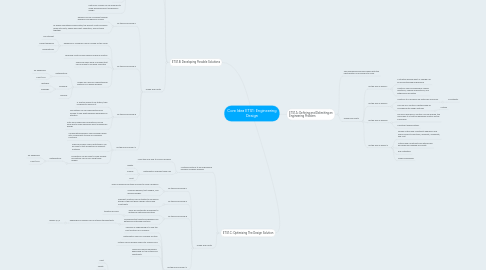
1. ETS1.B: Developing Possible Solutions
1.1. The creative process of developing a new design to solve a problem is the central element of engineering
1.2. Models are used for understanding features of a design problem
1.2.1. Mathematical
1.2.1.1. 3D Rendering
1.2.1.2. CAD/CAM
1.2.2. Graphical
1.2.2.1. Sketches
1.2.2.2. Drawings
1.2.3. Physical
1.2.4. Data from models can be analyzed to make decisions about modifying a design
1.3. Grade End Points
1.3.1. By the end of grade 2
1.3.1.1. Designs can be conveyed through graphical and physical models
1.3.1.2. To design something complicated, the project must be broken down into parts, design each part separately, and put back together.
1.3.2. By the end of grade 5
1.3.2.1. Research of a problem can be carried out by using
1.3.2.1.1. The Internet
1.3.2.1.2. Market Research
1.3.2.1.3. Observations
1.3.2.2. Research must be done before finding a solution
1.3.2.3. There are many kinds of models that can be made to visualize a solution
1.3.2.4. Models are used for understanding features of a design problem
1.3.2.4.1. Mathematical
1.3.2.4.2. Graphical
1.3.2.4.3. Physical
1.3.3. By the end of grade 8
1.3.3.1. A solution needs to be tested, then modified to improve it
1.3.3.2. Simulations can be implemented from models to see what happens depending on situation
1.3.3.3. Data from models and simulations can be analyzed to make decisions about modifying a design
1.3.4. By the end of grade 12
1.3.4.1. Complicated problems can be broken down into components to work on individual functions.
1.3.4.2. Physical models called "prototypes" can be used to test properties of different materials
1.3.4.3. Computers can be used to make models. Simulations can be run using these models.
1.3.4.3.1. Mathematical
2. ETS1.C: Optimizing The Design Solution
2.1. Multiple solutions to an engineering problem is always possible
2.1.1. More than one way to solve a problem
2.1.2. Optimization requires trade offs
2.1.2.1. Lighter
2.1.2.2. Smaller
2.1.2.3. Cost
2.2. Grade End Points
2.2.1. By the end of grade 2
2.2.1.1. There is always more than one way to solve a problem
2.2.1.2. Compare designs, test designs, and discuss designs
2.2.2. By the end of grade 5
2.2.2.1. Different solutions can be tested to see which design is the best given design criteria and constraints
2.2.3. By the end of grade 8
2.2.3.1. There are systematic processes to determine optimized solutions
2.2.3.1.1. Iterative process
2.2.3.2. Comparing test results and designs can determine optimized solutions
2.2.3.2.1. Redesigns of designs can be utilized through tests.
2.2.4. By the end of grade 12
2.2.4.1. The goal of engineering is to find the best solution for a problem.
2.2.4.2. Optimization can be a complex solution
2.2.4.3. Criteria can be broken down into smaller ones
2.2.4.4. Trade offs may be necessary depending on the criteria and constraints
2.2.4.5. When evaluating solutions, consider these impacts
2.2.4.5.1. Cost
2.2.4.5.2. Safety
2.2.4.5.3. Reliability
2.2.4.5.4. Environment
2.2.4.5.5. Asthetic
2.2.4.5.6. Social
2.2.4.5.7. Cultural
2.2.4.6. Testing should lead to improvements through the iterative process
2.2.4.6.1. Versions
3. ETS1.A: Defining and Delimiting an Engineering Problem
3.1. The engineering process begins with the identification of a problem to solve.
3.2. Grade End Points
3.2.1. By the end of grade 2
3.2.1.1. A situation people want or change can be solved through engineering
3.2.1.2. Solutions can be achieved by asking questions, making observations, and gathering information
3.2.2. By the end of grade 5
3.2.2.1. Solutions to a problem are limited by resources
3.2.2.1.1. Constraints
3.2.2.2. Success of a solution is determined by considering its design features
3.2.2.2.1. Criteria
3.2.3. By the end of grade 8
3.2.3.1. The more precisely a solution can be defined, the more likely it is that the designed solution will be successful.
3.2.3.2. Constraint specifications
3.2.4. By the end of grade 12
3.2.4.1. Design criteria and constraints address a end user's product's functions, durability, availability, and cost
3.2.4.2. Criteria and Constraints are determined by people and shaped by society
3.2.4.3. Risk Mitigation
3.2.4.4. Global Challenges

